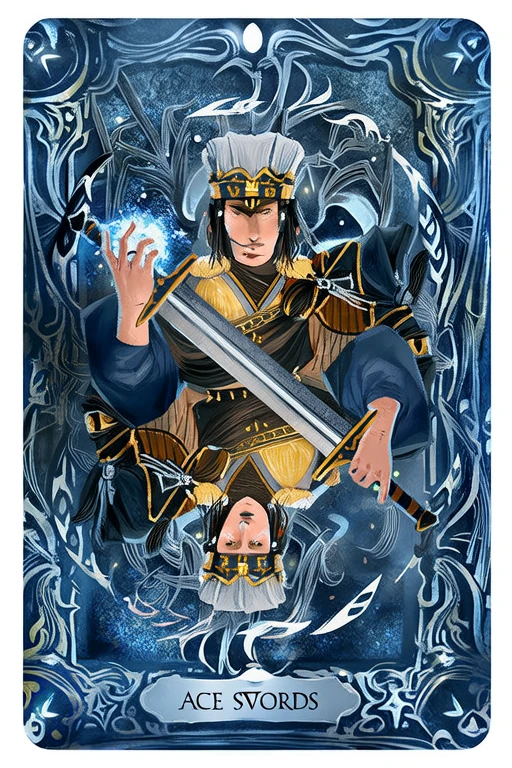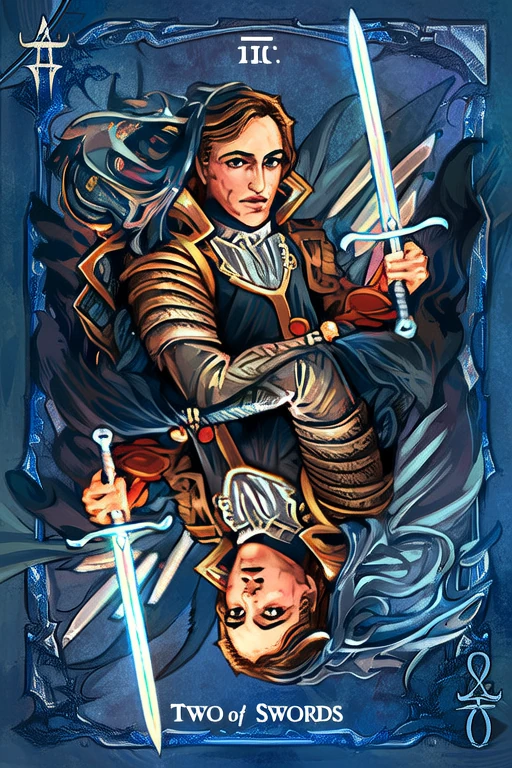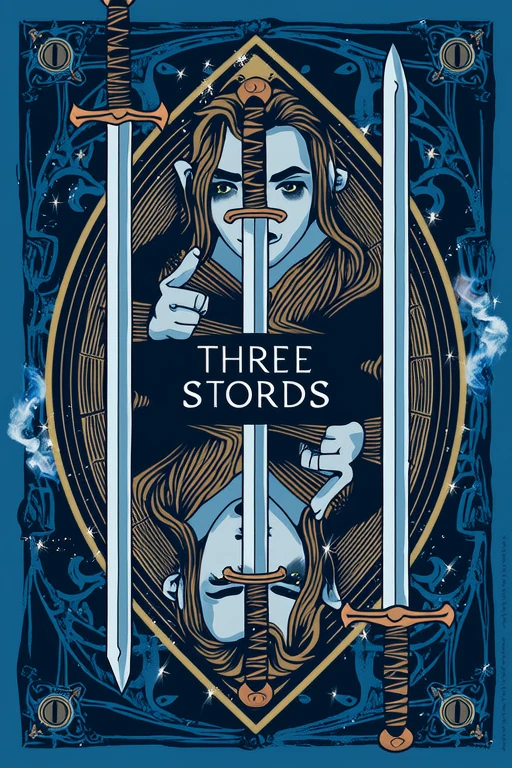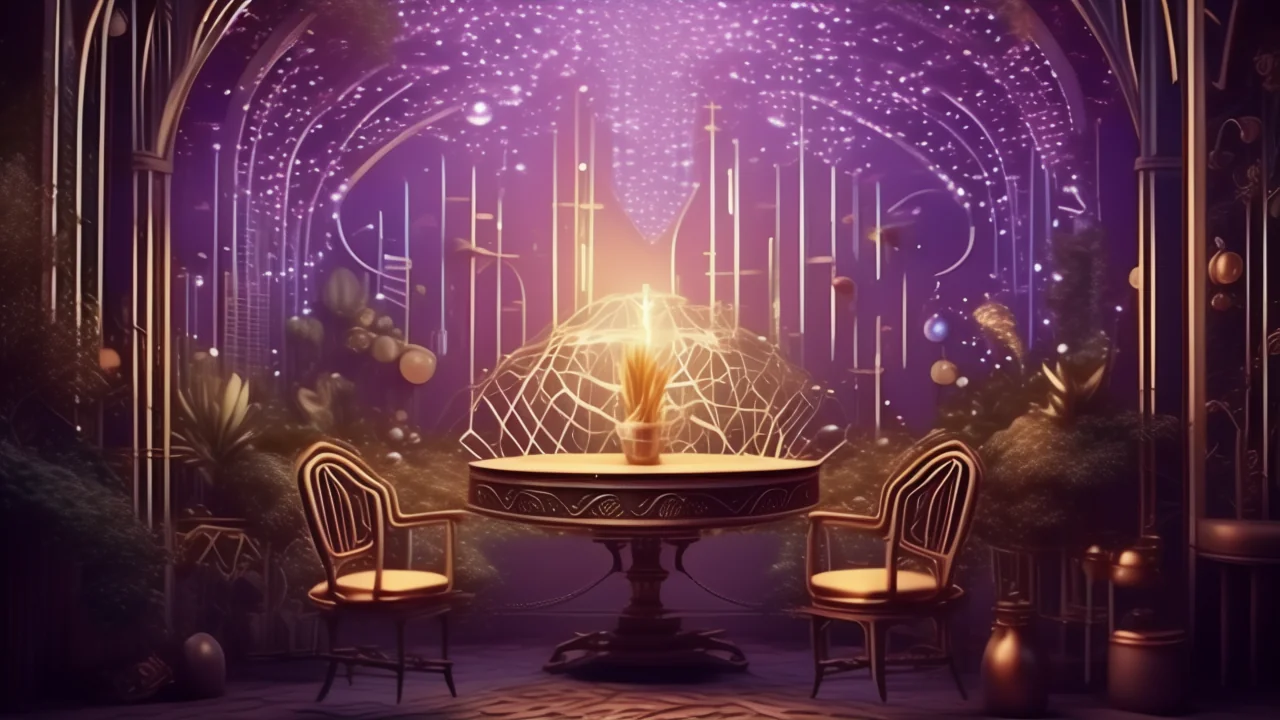
Ten of Swords
Discover the deep meaning of Ten of Swords with our free AI-powered tarot interpretation. Get instant, accurate readings based on advanced tarot knowledge.
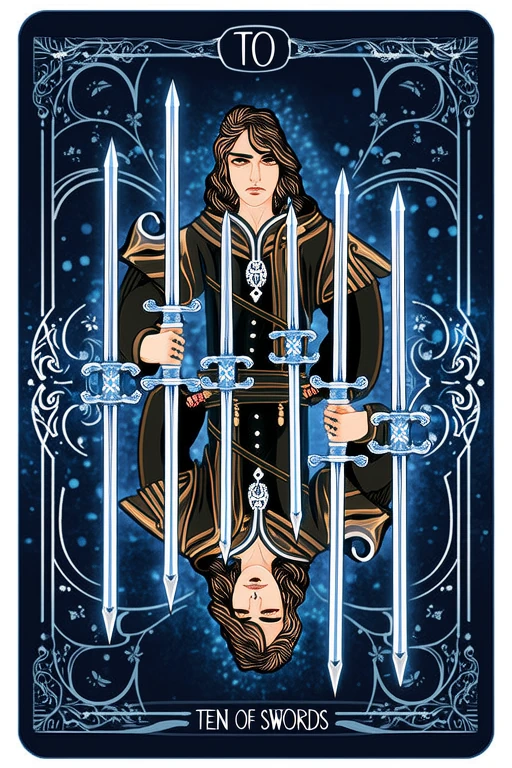
Keywords
Upright Meaning
Painful endings, deep wounds, betrayal
Reversed Meaning
Recovery, regeneration, resisting inevitable
Full Interpretation
The Ten of Swords represents painful endings, deep wounds, and the need to let go.
In-Depth Analysis
📜 Historical Background
The Ten of Swords, known in Chinese as 宝剑十 (Bǎo Jiàn Shí), holds a unique and often misunderstood place in the tarot. As the final card of the Suit of Swords in the Minor Arcana, it is traditionally associated with the culmination of pain, betrayal, and emotional upheaval. Its origins trace back to early tarot decks used in 15th-century Europe, particularly in Italy and France, where the tarot was initially a game before evolving into a tool for divination and esoteric study.
In the earliest known tarot decks, such as the Visconti-Sforza and the Marseille Tarot, the imagery of the Ten of Swords was more abstract, often showing a figure pierced by multiple swords against a darkened sky. The design evolved significantly during the 18th and 19th centuries, particularly with the rise of occultism and the Hermetic Order of the Golden Dawn, which assigned deeper symbolic meanings to each card.
One of the most enduring interpretations of the Ten of Swords comes from Arthur Edward Waite’s Rider-Waite-Smith deck (1909), illustrated by Pamela Colman Smith. In this version, a man lies face down with ten swords plunged into his back, symbolizing betrayal, loss, and the end of a painful cycle. The image is stark and dramatic, and it has become the standard for many modern decks.
Across different cultures, the card has been interpreted through various lenses. In some European traditions, it was seen as a harbinger of death or disaster, while in others, particularly in modern spiritual tarot, it is viewed as a message of release and transformation. The number ten in numerology represents completion and the end of a cycle, reinforcing the idea that while the experience may be painful, it is also necessary for growth.
Throughout history, the Ten of Swords has often been associated with betrayal, deception, and sudden loss. Some mythological parallels have been drawn to figures like Odin from Norse mythology, who endured great suffering for wisdom, or the biblical Judas, representing ultimate betrayal. These associations have helped shape the card’s symbolic weight across different tarot traditions and cultures.
Today, the Ten of Swords remains a powerful symbol in tarot readings, often indicating the end of a difficult period and the potential for rebirth after a major emotional or psychological crisis.
Symbolism & Imagery
The Ten of Swords is rich in symbolic meaning, with each visual element contributing to its overall message. At the center of the card lies a man lying face down, his back pierced by ten swords. His arms are outstretched, and his body is still, suggesting finality and surrender. Behind him, a dark sky looms, broken only by the faint light of dawn on the horizon—an early indication that the worst has passed and a new beginning is possible.
The swords themselves are the dominant feature of the card. As weapons of the mind and intellect, swords in the tarot represent thoughts, decisions, and communication. Ten is a number of completion and culmination, suggesting that the situation being referenced has reached its peak intensity. The fact that all ten swords are embedded in the man’s back implies betrayal, often from multiple sources or a culmination of betrayals over time.
Color symbolism also plays a crucial role. The dark sky and muted landscape reflect emotional turmoil and despair, while the small patch of light at the horizon suggests hope and renewal. The lifeless body may symbolize the death of a part of the self—whether it be a relationship, a career, or a belief system—that can no longer serve the individual.
Interpretations of the Ten of Swords vary across cultures and tarot traditions. In some older European decks, the card was seen as a literal omen of death or misfortune. However, modern interpretations tend to focus more on metaphorical death—such as the end of a painful situation or the conclusion of a difficult chapter in life.
When the Ten of Swords appears upright in a reading, it often indicates betrayal, emotional pain, or a situation that feels overwhelming. It may suggest that the querent has reached a breaking point and that the worst is now behind them. Reversed, the card can indicate a reluctance to accept the end of a painful situation or the beginning of healing after a traumatic event.
The Ten of Swords is closely related to other cards in the Suit of Swords, particularly the Nine of Swords, which represents anxiety and guilt, and the Eight of Swords, which symbolizes feeling trapped or restricted. Together, these cards form a narrative of mental and emotional suffering leading to a final release or realization.
Ultimately, the Ten of Swords serves as a reminder that even the most painful experiences can lead to growth and transformation. It is not a card of permanent doom, but rather one of necessary endings and the promise of renewal.
Psychological Insights
From a psychological perspective, the Ten of Swords can be interpreted as a powerful representation of the human experience of loss, betrayal, and emotional trauma. Carl Jung, the Swiss psychiatrist and founder of analytical psychology, described archetypes—universal symbols and themes that appear across cultures and time. The Ten of Swords aligns closely with the archetype of the Martyr or the Wounded Healer, figures who undergo intense suffering but ultimately emerge with greater wisdom and understanding.
In modern life, this card often surfaces during times of crisis, particularly when someone feels overwhelmed by betrayal, failure, or injustice. It may appear in readings when a person is facing the aftermath of a significant emotional blow—such as the end of a relationship, a job loss, or a personal failure. Psychologically, the card encourages the querent to acknowledge the pain fully rather than suppress or deny it, as this is the first step toward healing.
Decision-making under the influence of the Ten of Swords often involves letting go of something that has already ended or cannot be saved. It challenges individuals to move beyond denial and accept reality, even when it is painful. This card encourages resilience and the understanding that while the experience is devastating, it is also a necessary step in personal growth.
In the realm of personal development and self-awareness, the Ten of Swords teaches the importance of closure and transformation. It reminds individuals that sometimes, the most painful moments in life are those that lead to the greatest growth. By facing the truth and allowing oneself to grieve, one can begin the process of rebuilding and renewal.
Therapeutically, the card can be a useful tool in counseling and shadow work. It helps clients confront their deepest fears and traumas, encouraging them to process painful emotions rather than avoid them. Counselors and spiritual guides may use the Ten of Swords to facilitate discussions around betrayal, loss, and emotional resilience.
In modern spiritual practices, the Ten of Swords is often associated with karmic lessons and soul evolution. It signifies a moment of reckoning, where the soul must confront past actions or experiences in order to move forward. Meditating on this card can help individuals release old wounds and embrace a new beginning with clarity and strength.
Correspondences
The Ten of Swords is associated with the planet Saturn and the zodiac sign Libra in many esoteric traditions. Saturn, the great teacher of discipline and structure, brings a sense of karmic consequence and the necessity of facing hard truths. Libra, an air sign ruled by Venus, adds themes of balance, justice, and the need to resolve conflict—often through painful but necessary experiences.
In terms of gemstones and crystals, obsidian, black tourmaline, and hematite are commonly linked with the Ten of Swords. These stones are known for their grounding and protective properties, helping to absorb negativity and promote emotional healing. Herbs such as sage, myrrh, and lavender can be used in rituals or smudging to clear emotional blockages and support recovery after a traumatic event.
Essential oils like frankincense, rosemary, and vetiver are also associated with this card, offering calming and centering effects that aid in processing grief and emotional pain. These oils can be used in aromatherapy sessions or during tarot meditation to deepen the connection with the card’s energy.
Elementally, the Ten of Swords corresponds to Air, the element of intellect and communication, reinforcing its connection to mental and emotional pain. It is often linked to the autumn season, a time of endings and preparation for renewal, and to the waning phase of the moon, symbolizing release and letting go.
In energy work, the card is associated with the Root Chakra, which governs survival and grounding. When this chakra is imbalanced, feelings of betrayal and instability can arise, making the Ten of Swords a powerful tool for realigning and stabilizing one’s energetic foundation.
Numerologically, the number ten represents completion and the end of a cycle. It carries the energy of both the number one (new beginnings) and zero (wholeness and potential), indicating that while the pain may be intense, it is also a gateway to a new phase of life.
❓ Frequently Asked Questions
The Ten of Swords is one of the most emotionally charged cards in the tarot, and it often raises a number of questions among both beginners and experienced readers. One of the most common inquiries is whether the card literally predicts betrayal or death. The answer lies in understanding that tarot speaks in symbols, and the Ten of Swords typically represents metaphorical endings—such as the end of a relationship, career, or mindset—rather than physical death.
Beginners often misinterpret the card as purely negative, but seasoned readers understand that it signifies a necessary conclusion. It's not about doom, but about reaching the end of a painful cycle so that healing and renewal can begin. Clarifying this point is essential for accurate and compassionate readings.
Professional readers use specific techniques when interpreting the Ten of Swords. In tarot spreads like the Celtic Cross or the Three-Card Spread, the placement of the card is crucial. If it appears in the past position, it may indicate that the worst has already happened and the querent is moving beyond it. In the present or future positions, it could suggest that the querent is currently experiencing a painful situation or is about to face a difficult revelation.
This card often interacts with other cards in the Suit of Swords, particularly the Nine of Swords (anxiety and guilt) and the Eight of Swords (feeling trapped). When paired with Major Arcana cards like Death or The Tower, the Ten of Swords reinforces themes of transformation, upheaval, and the necessity of letting go.
For practical interpretation, it’s important to consider the querent’s emotional state and the surrounding cards. Encourage them to reflect on what in their life may be ending or needing release. Remind them that while the card is painful, it is also a sign of resolution and the beginning of healing. Use gentle, empathetic language and offer support in navigating the transition the card represents.
Practical Readings
Love Reading – Free • Online • AI • Instant • Accurate
In love, Ten of Swords upright: Painful endings, deep wounds, betrayal. Reversed: Recovery, regeneration, resisting inevitable.
Career Reading – Free • Online • AI • Instant • Accurate
For career, Ten of Swords upright: Painful endings, deep wounds, betrayal. Reversed: Recovery, regeneration, resisting inevitable.
Yes‑No Reading – Free • Online • AI • Instant • Accurate
As a quick yes‑no: upright tends toward “yes”, reversed leans “no”—interpret within your question’s context.
FAQ
What does Ten of Swords mean in tarot?
Ten of Swords represents painful endings, deep wounds, betrayal. This card encourages The Ten of Swords represents painful endings, deep wounds, and the need to let go.
What is Ten of Swords reversed meaning?
When Ten of Swords appears reversed, it signifies recovery, regeneration, resisting inevitable. Consider areas that may require adjustment or release.
Is Ten of Swords a positive card?
Ten of Swords is generally considered a neutral to positive card, representing painful endings, deep wounds, betrayal.
What should I do if I draw Ten of Swords?
If you draw Ten of Swords, focus on painful endings, deep wounds, betrayal. Align actions with the card’s upright energy.
How do I interpret Ten of Swords in a love reading?
In love readings, Ten of Swords suggests painful endings, deep wounds, betrayal in relationships. Consider how painful endings and deep wounds apply to your situation.
What does Ten of Swords mean in a love reading?
In love, Ten of Swords points to painful endings, deep wounds, betrayal when upright and recovery, regeneration, resisting inevitable reversed. Reflect on relational balance & authenticity.
How is Ten of Swords interpreted in career?
For career, Ten of Swords upright highlights painful endings, deep wounds, betrayal while reversed warns of recovery, regeneration, resisting inevitable—adjust planning & execution.
What is the financial meaning of Ten of Swords?
Financially, Ten of Swords suggests painful endings, deep wounds, betrayal potential; reversed indicates recovery, regeneration, resisting inevitable—use prudent pacing.
Is Ten of Swords a yes or no card?
Ten of Swords is generally a context-dependent when upright; reversed leans toward hesitation or NO—apply to the nuance of your question.
References
References
- Encyclopaedia Britannica – Tarot
Historical overview and cultural context of tarot cards.
- Wikipedia – Tarot
General reference on tarot history, structure, and usage.
- Biddy Tarot – Tarot Card Meanings
Widely cited interpretations and learning resources.
- Labyrinthos – Tarot Card Meanings
Educational articles on major and minor arcana.
